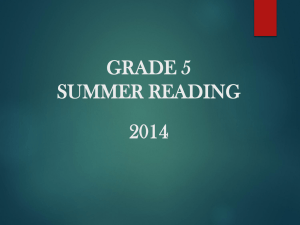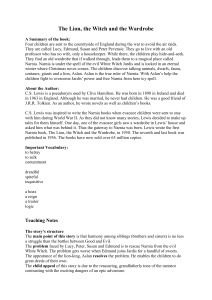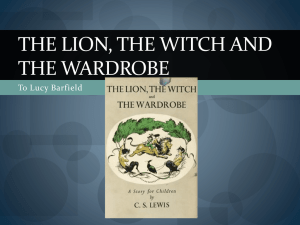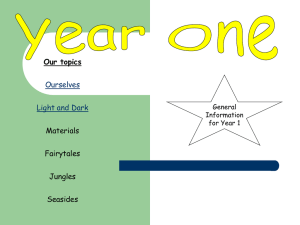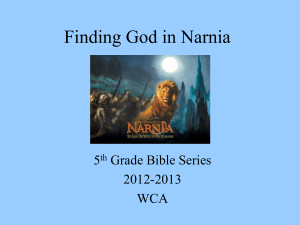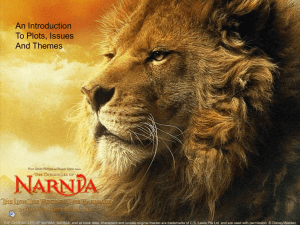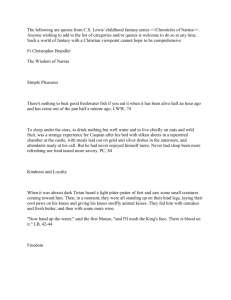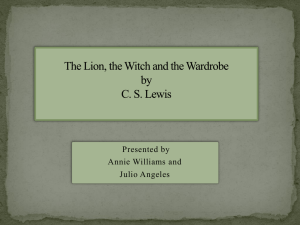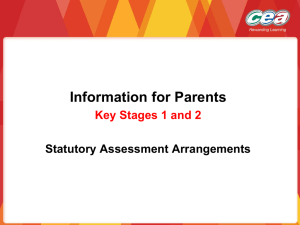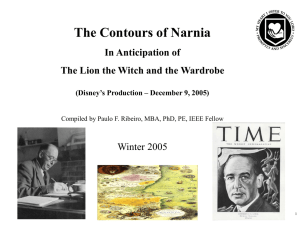Cross-curricular links
advertisement
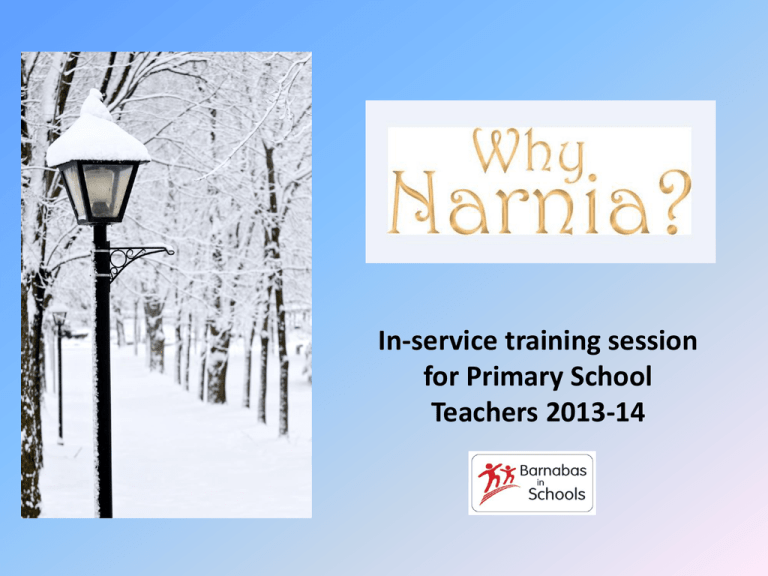
In-service training session for Primary School Teachers 2013-14 INSET Creative Barnabas RE Day (Reception to Year 6) … The workshop leader really engaged the children throughout the assembly. This was a lively and appetite-whetting introduction that paved the way into age-appropriate workshops for the children… Website support materials Teaching Narnia resource book C.S. Lewis Born 29 November 1898 Died 22 November 1963 2013 marks the 50th anniversary of his death C.S. stands for: Cuthbert Sidney Clive Staples Conrad Stanley? Clive Staples C.S. Lewis studied at: Durham Cambridge Oxford? Oxford In 1917, C.S. Lewis... Got married Went to fight in WWI Graduated? Went to fight in WWI In 1931, C.S. Lewis... Became a Christian Got married Graduated? Became a Christian In 1951, C.S. Lewis turned down which award: MBE Carnegie medal OBE? OBE In 1956, C.S. Lewis... Received an MBE for his writing Received the Carnegie medal for The Last Battle Got married? Received the Carnegie medal Got married C.S. Lewis died in: 1959 1961 1963? 1963 C.S. Lewis died on the same day as which well-known US politician? John F. Kennedy 22 November 1963 Introducing The Chronicles of Narnia books How do they all fit together? Chronological order (publication date in parens) The Magician’s Nephew (1955) The Lion, the Witch and the Wardrobe (1950) The Horse and His Boy (1954) Prince Caspian (1951) The Voyage of the Dawn Treader (1952) The Silver Chair (1953) The Last Battle (1956) Common assumptions of parallels between the Narnia story and Christian life Aslan – Jesus Witch – Devil Stone Table – Cross Exploring some key questions What is really real? How do we see the world? Who is in charge of the world? Is God really good? Does God exist at all? What happens after death? How do we know what is right and wrong? Other questions Exploring some key questions: 1 What is really real? What things do religious believers say are real? God, heaven… Book link: Lucy comes back from the wardrobe and isn’t believed by the others. LWW, Chapter 3: Edmund and the Wardrobe How do we see the world? Is the world a good or bad place? Use examples from news stories the children may have heard or seen How do Christian’s view the world? God’s world? Book link: Mr Tumnus and his reflections on Narnia with the White Witch in control. LWW, Chapter 2: What Lucy found there Exploring some key questions: 2 Who is in charge of the world? Who do you think is in charge of the world? How do you know? Who do Christians believe is in charge of the world? How do they know? Book links: Conversation between the White Witch and Edmund. LWW, Chapter 4: Turkish Delight. LWW, Chapter 11: Aslan is nearer Is God really good? Do we need evidence to prove that God is good? Book link: The Beavers have hope in something better. LWW, Chapter 8: What happened after Dinner Exploring some key questions: 3 Does God exist at all? Why do Christians say that God exists? That God is real? What evidence would you need to believe that God exists? Book links: Example of Peter. LWW, Chapter 8: What happened after Dinner. LWW, Chapter 12: Peter’s First Battle What happens after death? Is there life after death? Book link: Lucy/Susan - depth of bereavement. LWW, Chapter 14: The Triumph of the Witch Exploring some key questions: 4 How do we know what is right and wrong? Who tells us what is right and wrong? Book link: Edmund and White Witch - Turkish Delight. LWW, Chapter 4: Turkish Delight Other questions? Are these stories out of date - gender stereotypical? Is this a fair reflection of Christian ideas? Exploring Narnia and Christianity – a reflective story An alternative interactive activity is also available. Cross-curricular links Literacy Art ICT Geography Music PSHE Cross-curricular links: 1 Literacy Foundation Descriptive writing: Using a picture of a lion, write words around the outside to describe what the lion looks like or the characteristics of a lion. Word wardrobe: Make a wardrobe from a box with two flaps, then either write frequently occurring words on card and put them in the box or, if adventurous, include a rail with small plastic coat hangers and hang the words from the hangers. Sequencing the story: Put pictures of the story in order with words or sentences depending on age. Literacy Cross-curricular links: 2 Foundation (cont.) Storyboard: Select four to six pictures from the story and then write a sentence for each one. Story sack: Put a selection of related items in a bag and use to retell the story. Colours of Narnia: Read the section from 'The Lion, the Witch and the Wardrobe' where Father Christmas gives gifts - Chapter 10: The Spell begins to break, from the sixth page It was a sledge... to ... not to be in the battle (two pages on). What colours do you associate with this story? Creative writing: What would be your perfect meal? Describe it in the same creative way. Literacy Cross-curricular links: 3 Key Stage 1 Generating vocabulary: Using an imaginary wardrobe, discuss what is on the other side, what you can see, what you can hear, how you feel. Key Stage 1 and 2 Exploring text: Choose a story and see how could it be developed as pure literacy. For example, the meal at the Beavers - adjectives, adverbs, verbs, abstract nouns - to create interest, taste, textures. Key Stage 2 Selecting main elements: Choose a passage. What are the main elements? What questions would the writer have in mind? Create a play script of a minute. Art Cross-curricular links: 4 Foundation and Key Stage 1 Putting it back together: A significant theme throughout 'The Lion, the Witch and the Wardrobe' is that of places, objects and people being destroyed followed by restoration and rebuilding. Using broken items (without sharp edges) brought in from home, or torn-up art materials, work in groups to see what beautiful things can be created out of spoiled and broken parts (junk modelling, collage, mosaic). Designing: Design your own DVD cover/book cover for 'The Lion, the Witch and the Wardrobe'. What would you include? Cross-curricular links: 5 Art Key Stage 1 and 2 From words to pictures: Read a section from midway in Chapter 7: A Day with the Beavers - for example, from Above the dam... - which describes the walk from the Beavers' house to meet Aslan and his army. Using this passage, draw a picture to describe what you think Narnia would look like. At the end of the book, Aslan dies. In Chapter 17: The Hunting of the White Stag, there is a description of Narnia afterwards. Using this passage, draw a picture to describe what you think Narnia would look like now. Cross-curricular links: 6 Art Key Stage 1 and 2 (cont.) From pictures to words: Choose a 'picture frame' from the story and write a story or poem about it. For example: •The lamp post •The meal with beavers •The fawn with umbrella •The Stone Table with Aslan still alive surrounded by nasty creatures •The Stone Table after Aslan has died and Lucy and Susan are crying beside him Cross-curricular links: 7 Art Key Stage 2 Bible link: Develop the theme using the Bible verses from Isaiah 61:2-4 (CEV). How might these verses be illustrated visually using colour and textures? Story sketching: Using the concept of trees, which are often referred to throughout the story, consider different types of trees and sketch them. Enhance further by adding snow, frost and icicles. Cross-curricular links: 8 Art Extension: Foundation, Key Stage 1 and 2 Design your own fantasy world. Or, for those who haven't seen the film/book: Foundation: Show a clip from the film and try to recreate it using different materials. KS1 and KS2: Read one of the passages describing a character's first meeting with the fawn - for example, Chapter 1: Lucy looks into a Wardrobe, from the end of the penultimate paragraph ... soon after that a very strange person... to the end of the chapter. Draw what you think he may look like. Cross-curricular links: 9 ICT Key Stage 1 and 2 The four seasons: From a picture of a tree, create four pictures of the tree in the four different seasons. Story data gathering: Choose six different parts from the story and gather data as to which part people liked best. Create a graph showing the results. Finally, offer an explanation for your results, suggesting reasons for the range of preferences. Cross-curricular links: 10 Geography Key Stage 2 Create a map of Narnia: Look at examples of old maps available on the Internet and then design your own, showing the landscape - hills, rivers, forest, coastline - and using symbols and labels to identify key locations from the story - such as Cair Paravel, the Great Sea, the White Witch's castle, the Beavers' lodge, Mr Tumnus' house, the street lamp in the forest, the Stone Table. Compare your ideas with those of others - what's similar and different? Having made the map, you could expand further by adding a grid, then providing grid references for the main narrative points of the story. Cross-curricular links: 11 Music Key Stage 1 and 2 From words to sound: Using the following passages from the book that describe the passing of winter into spring, suggest what instruments you might use to represent these various stages, including volume and pace. • Chapter 11: Aslan is nearer, midway in the chapter, midway in the para [Now they were steadily racing...], from ...And in that silence Edmund... to ... of a fir tree... (just before the end of the para). • Chapter 11: Aslan is nearer, towards the end of the chapter, from Every moment the patches... to ... from January to May near the beginning of the second para in Chapter 12: Peter's First Battle. Cross-curricular links: 12 Music Key Stage 1 and 2 (cont.) Creating a soundscape: Using a clip from the film, design a soundscape and then listen to the actual soundtrack to the film. Alternatively, listen to sections of Vivaldi's Four Seasons, then use instruments/sounds to compose a soundscape for one of the seasons. This could be done in groups, with each group being assigned a season. Then, the class could put them together to produce a soundscape for the four seasons. Cross-curricular links: 13 PSHE Foundation and Key Stage 1 Exploring emotions Referring to the description in the story about how Edmund treated Lucy with disbelief when she returned from the wardrobe (see Chapter 3: Edmund and the Wardrobe), discuss how we treat others. How do we feel when something is true and someone says it's not? Buy or make a 'book' box. Discuss what words describe the emotions of Narnia, then write them down and place them in the book. (Hobbycraft sell these or they can be made from a box file.) Resources Support materials on Barnabas in Schools website: http://www.barnabasinschools.org.uk/why-narnia-support-material A resource book: Teaching Narnia A six-week scheme of work, by kind permission of Guildford Diocesan Board of Education: http://www.cofeguildford.org.uk/assets/downloads/departments/education/re_cw/narniauks2.pdf Acknowledgements Image ©2013 Thinkstock Barnabas in Schools is part of The Bible Reading Fellowship, a Registered Charity BRF, 15 The Chambers, Vineyard, Abingdon, Oxon OX14 3FE Tel: 01865 319700 Fax: 01865 319701 Email: barnabas@brf.org.uk www.barnabasinschools.org.uk

